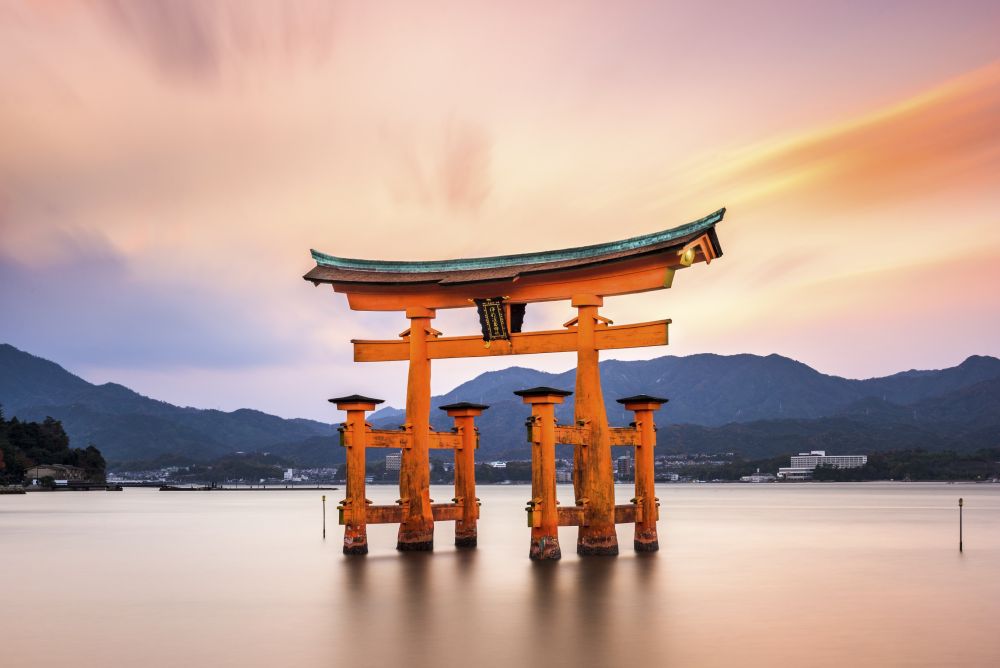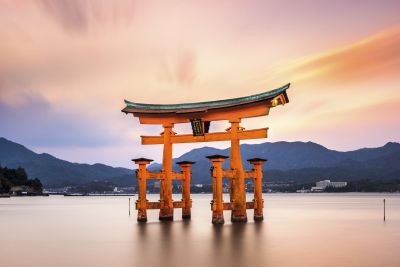

Itsukushima Shrine is a renowned Shinto shrine on the island of Miyajima. It is famous for its 'floating' torii gate, which appears to be standing in the sea during high tide. Visitors can stroll along the shrine's long, open-air corridors, admire its architecture, and enjoy the serene atmosphere. The shrine complex includes several buildings connected by boardwalks, including a prayer hall, a main hall, and a Noh drama stage. Itsukushima Shrine is designated as a UNESCO World Heritage Site and is considered one of Japan's top three scenic views. The tranquility, combined with the spiritual ambiance and the breathtaking backdrop of the sea and Mount Misen, creates an unforgettable experience for every visitor. The shrine is host to many festivals throughout the year, making it a bustling place of celebration at times, while maintaining its sense of sacredness and poise.
While visiting Itsukushima Shrine, you can also engage in hands-on traditional craft experiences. The island of Miyajima is famous for its woodworking, particularly the Miyajima Shakushi (rice scoops). Visitors have the opportunity to learn from local artisans and create their own rice scoop. This experience is not only about crafting a souvenir but also about understanding the island's cultural heritage and the intricate work that goes into making these traditional items. The unforgettable experience leaves visitors with a personalized souvenir and a deeper appreciation for Miyajima's unique crafts.
Mount Misen is the highest peak on Miyajima and provides a challenging hike with rewarding views. From Itsukushima Shrine, visitors can reach the mountain via the Miyajima Ropeway or by foot. Hikers can enjoy numerous trails leading to the summit, where sweeping views of the Seto Inland Sea await. Along the way, one can visit the Reikado hall featuring the eternal flame said to be burning for over 1200 years, which was used to light the Flame of Peace in Hiro Musa's Peace Memorial Park. Hiking Mount Misen allows visitors to immerse themselves in the natural beauty surrounding Itsukushima Shrine and perhaps spot some wildlife, such as friendly deer, along the way.
Kayaking around the waters of Miyajima is a peaceful and captivating way to explore the island and enjoy the scenic beauty of Itsukushima Shrine from a different perspective. As the sun begins to set, the torii gate and shrine are bathed in a warm, golden light, creating a stunning landscape that is perfect for photography enthusiasts and nature lovers alike. Kayaking tours usually include all necessary equipment and are led by experienced guides who ensure both safety and a fulfilling adventure. The tranquil waters of the Seto Inland Sea offer a rare chance to see the shrine in the soft twilight, making for an unforgettable experience.
After exploring Itsukushima Shrine, a walk through Omotesando Shopping Street is a must. This bustling street is lined with shops and eateries offering a variety of goods, from traditional crafts to mouthwatering street food. Visitors can find everything from souvenirs like the iconic wooden rice scoops and Momiji manju (maple leaf-shaped cakes with sweet fillings) to fine Miyajima lacquerware. Exploring Omotesando provides a delightful experience that highlights the local flavors and craftsmanship, all within a stone's throw from the scenic Itsukushima Shrine.
Not far from Itsukushima Shrine is Daisho-in, one of the most significant Buddhist temples on Miyajima. With over a thousand years of history, Daisho-in features a variety of buildings, statues, and religious artifacts. Visitors can walk around the temple grounds, discover the cave filled with 88 icons representing the Shikoku Pilgrimage, and enjoy the calming Buddhist chants. The temple also offers stunning views of the island and its surroundings. A visit here complements the Shinto experience at Itsukushima Shrine, offering a sense of peace and a deeper understanding of Japanese religious traditions.
At Itsukushima Shrine, visitors can occasionally witness traditional Noh theater performances on a stage that beautifully overlooks the sea. This classical Japanese musical drama, often performed with elaborate costumes and masks, is a captivating element of Japan's cultural heritage. Itsukushima Shrine hosts these performances in a stunning setting that enhances the surreal and otherworldly atmosphere of the plays. Attending a Noh performance here is a unique opportunity to immerse oneself in a centuries-old art form while surrounded by the shrine's elegant architecture and the natural beauty of Miyajima.
The Miyajima Water Fireworks Display is an annual event held in August, featuring a spectacular fireworks show set against the backdrop of Itsukushima Shrine and the floating torii gate. The reflection of the fireworks on the water surface creates a mesmerizing view, captivating tens of thousands of visitors each year. It's a festival atmosphere with food stalls and lively celebrations. Visitors should secure a good viewing spot early, as this is one of the most popular events on the island. Experiencing the fireworks here is a perfect way to appreciate the harmonious blend of natural beauty, culture, and festivity that Miyajima offers.
Located at the foot of Mount Misen near Itsukushima Shrine, Momijidani Park is one of the most famous maple leaves valleys in Japan. Rich in color with over 200 maple trees, the park offers a scenic spot for relaxation and picnics, especially during autumn when the foliage is spectacular. Visitors can enjoy a leisurely walk, watch the freely roaming deer, and take in the peaceful ambiance of the park. A picnic here is a great way to unwind and spend quality time in nature after touring the surrounding cultural landmarks.
Within close proximity to Itsukushima Shrine, the Treasure Hall museum is home to over 4,000 historical artifacts related to the shrine, including Heian-period Buddhist sutras, samurai armor, and ancient scrolls. Visitors to the museum will gain insight into the rich history of Itsukushima Shrine and its place within Japanese culture. The collection gives context to the shrine's religious importance and showcases the artistry of different periods in Japan's history. The museum is a must-visit for history enthusiasts and anyone interested in deepiftsukushima Shrine beyond its physical structures.
